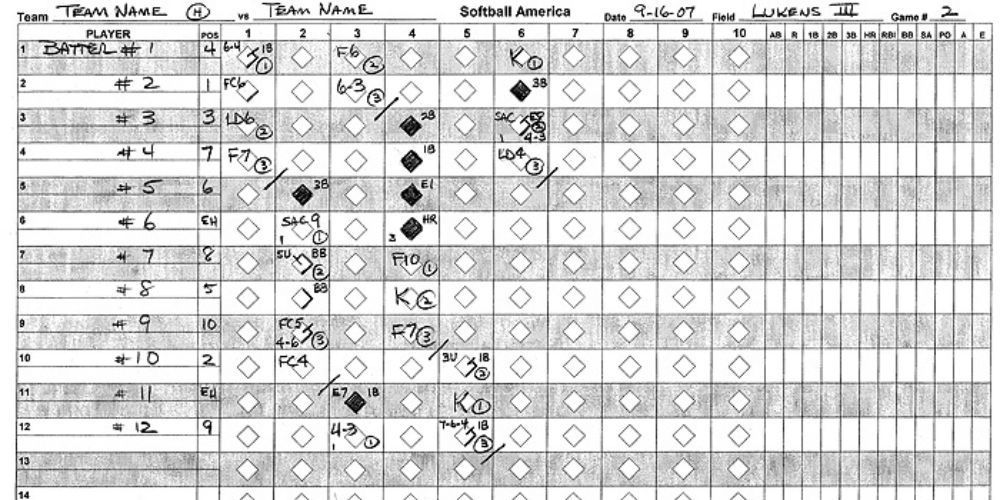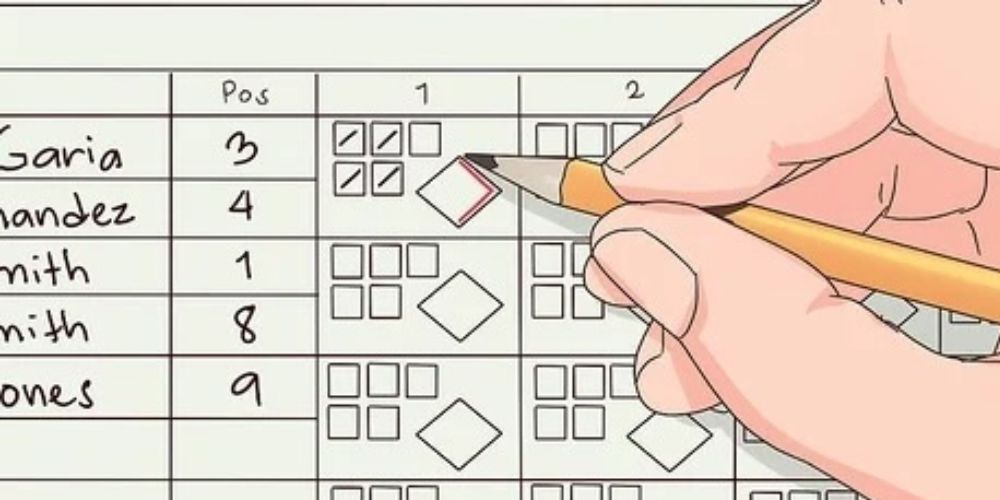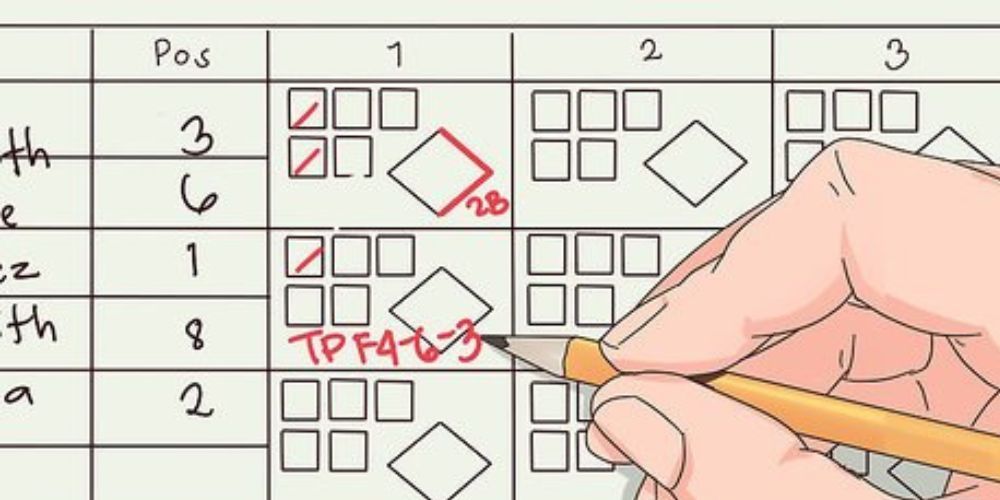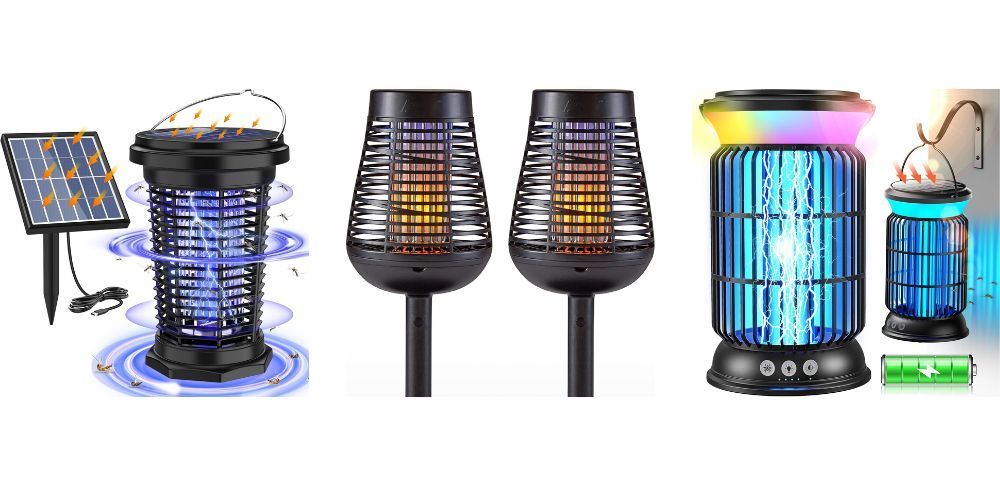The Ultimate Guide to Keeping a Detailed Softball Scorebook: Record Every Game Like a Pro
July 7, 2024
Keeping a detailed softball scorebook can feel like juggling pins while riding a unicycle—especially when you’re not just a spectator but actively coaching and making split-second decisions on the field. For many passionate coaches like yourself, missing important plays or struggling with unclear notations can turn an exhilarating game into a source of stress.
To ensure you capture every hit, pitch, and steal with professional precision, we've poured extensive research and practical insights into this guide. Imagine knowing exactly which scorebook best matches your needs or discovering how simple pre-game preparations can make all the difference. With practical tips straight from seasoned scorekeepers and easy-to-follow templates, we’ll help you turn chaotic record-keeping into a seamless part of your coaching strategy.
Keeping a detailed softball scorebook involves accurately recording each play, including balls, strikes, runs, and player positions. Utilizing a specialized scorebook with pitch counts and space for notes about plays can help ensure thorough documentation of the game. It's crucial to learn proper scoring techniques and seek recommendations from experienced scorekeepers to maintain an accurate softball scorebook.

Get the Proper Materials for a Scorebook
The initial step in creating accurate and comprehensive softball scorebooks is selecting the right one. There are various types of scorebooks available, each designed with unique features to accommodate different needs. Some scorebooks include sections for detailed pitch counts, ensuring you capture every aspect of the game, while others focus on basic scoring elements. Brands like Franklin Sports, Rawlings, and Murray Sporting Goods have garnered a reputation for producing quality scorebooks that cater to a diverse range of requirements.
Consider your preferences and specific recording needs when choosing a scorebook. Ensure that the scorebook suits your individual needs and provides sufficient functionality. This tailored selection process sets the stage for meticulously recorded games, ensuring no critical detail goes unnoticed.
In addition to selecting a suitable scorebook, using the right accessories enhances your scorekeeping experience. Pencils with erasers are essential as they allow for easy corrections without compromising the clarity of your records. Additionally, colored pencils provide an effective method of differentiating between different types of plays in your scorebook, improving its readability and overall utility.
Moreover, investing in a sturdy clipboard is advantageous. It not only acts as a stable surface for writing but also helps keep your scorebook secure during the game, preventing potential mishaps caused by flimsy or unstable support. Having a backup scorebook at hand is also invaluable in unforeseen circumstances, safeguarding against any potential data loss or damage during gameplay.
Recommendations from experienced individuals can be immensely helpful in making an informed decision regarding scorebooks and accessories. Seek advice from seasoned coaches or veteran scorekeepers who possess valuable insights into user-friendly, comprehensive scorebooks. Their expertise can guide you toward selecting materials that ease the scoring process and contribute to accurate game documentation.
Equipping yourself with the proper materials ensures that you are fully prepared to keep detailed softball scorebooks effectively and efficiently. Making informed choices regarding your scorebook and accessories sets the foundation for precise game recordings and an enhanced overall experience.
Armed with the necessary tools and knowledge, it's time to dive into establishing a consistent scoring method to ensure uniformity across all your game recordings.
Establish a Consistent Scoring Method
So, with your scorebook at the ready, it's time to establish a method for keeping track of the action on the field. Consistency is key here. To truly record every game like a pro, it's essential to adopt a scoring system that remains the same from game to game, ensuring anyone reading your scorebook understands the game flow.
One way to achieve consistency in your scoring is to learn and use standard scoring symbols such as 'K' for strikeouts, 'BB' for walks, and 'E' for errors. These universally recognized notations serve as a common language for all softball enthusiasts. Consistent notation helps maintain accuracy and ensures clear communication when others review your scorebook, whether it's teammates, coaches, or players themselves.
In addition to using standard symbols, pre-game preparation is vital in setting the stage for accurate and detailed recording. Before each game, filling in the lineup including positions and numbers is an essential part of pre-game preparation. This crucial step supports accuracy and ensures there's no last-minute rush during gameplay. When you've prepared everything before the game starts, you can focus solely on capturing every play without any distractions or time pressure.
Imagine this: The pitcher throws a perfect strike, striking out the batter. You swiftly mark a ‘K’ in your scorebook, followed by a quick notation of the inning and any runners on base at the time—this systematic approach ensures that every play is recorded with precision and clarity.
Another efficient method involves using universally recognized symbols and notations along with visual representations for hits, walks, and players' moves around bases. For instance, you can use circles for hits, squares for walks, and lines indicating players’ movements around the bases. Clearly labeling each action as it occurs allows for quick reference during post-game analysis and facilitates seamless communication with fellow fans, players, or coaches.
By adopting a consistent scoring method comprising standard symbols and notations along with careful pre-game preparation and efficient methods like visual representations, you can effectively capture every aspect of the game in your scorebook like a true pro.
Moving beyond merely recording plays onto advanced strategies within the ballpark itself is just as crucial; let's explore how Positional Scoring Techniques add yet another layer of depth to comprehensively capturing softball games.
Positional Scoring Techniques
When keeping a detailed softball scorebook, accurately recording each player's movements and contributions is crucial. This encompasses their defensive positioning as well as their involvement in plays. Let's explore the key aspects of positional scoring to ensure that your scorebook becomes a comprehensive record of each game.
Field Positions Numbering
In softball, each position on the field has a specific number assigned to it for easy identification. For instance, the pitcher is denoted as 1, the catcher as 2, the first baseman as 3, and so forth up to 9 for the right fielder. This universal numbering system simplifies the process of recording plays in your scorebook. It's important to familiarize yourself with this numbering system to accurately record defensive plays and player movements.
For example:
- The designation "5" represents the third baseman.
- The label "8" signifies the center fielder.
Understanding these numbers makes it easier to track player positions and activities during the game.
Recording Positions in Action
Recording positions in action involves capturing the sequence of defensive plays through a notation system. For example, if there is a ground ball hit to the shortstop who then throws it to first base, you would record this play as "6-3" in your scorebook. The numbers correspond to the positions on the field, with "6" representing the shortstop and "3" indicating the first baseman.
By using this notation system, you can document every defensive play with precision, allowing for a comprehensive analysis of player performance and game dynamics.
Positional Notation Examples
To enhance your understanding of positional notation, consider a double play executed by the shortstop, second baseman, and first baseman. In this scenario, denote the play as "6-4-3 DP", with each number representing the position of the involved players - shortstop (6), second baseman (4), and first baseman (3). Including "DP" at the end signifies that it was a double play.
It's vital to annotate each player's involvement clearly to create an accurate account of defensive plays. By including these positional notations in your scorebook, you'll be able to look back at each game and understand how different players contributed defensively.
Remember, while it may seem daunting at first, practice makes perfect when it comes to mastering positional scoring techniques. As you become more familiar with them, they will seamlessly become part of your routine scorekeeping practices.
Diving into these nuanced strategies enriches your overall understanding of softball scoring. Now let's shift our focus to dive into scoring defensive plays—a critical aspect of keeping a detailed softball scorebook.
Scoring Defensive Plays
When it comes to scoring defensive plays in a softball game, accuracy and consistency are key. Each defensive play needs to be recorded accurately to ensure a comprehensive record of the game. This involves recording the type of play, the players involved, and the outcome of each defensive action.
Types of Defensive Plays and How to Score Them
Defensive plays in softball can range from routine groundouts to spectacular diving catches, and each play needs to be properly documented in the scorebook. Here's how you can document some common defensive plays:
- Groundout: When the ball is hit on the ground and a fielder throws out the batter at first base, mark it as "4-3" if it was a play made by the second baseman to the first baseman. The "4" signifies the second baseman, and the "3" represents the first baseman.
- Flyout: If a fielder catches a fly ball for an out, you would record it as "F" followed by the fielder's position number. For instance, a flyout caught by the center fielder would be marked as "F8". This consistent method allows for easy reference and accurate scoring.
- Strikeout: A strikeout is denoted by "K" in the scorebook. However, if the batter is called out on strikes while looking at a pitch without swinging, you would record it as "K-L" to signify a looking strikeout.
Let's say there’s a fly ball caught by the left fielder for the third out. In this case, you would simply mark "F7", indicating that it was a fly out to position 7. This consistent scoring method not only ensures accurate tracking but also provides a clear representation of what happened during the game.
Accuracy and Efficiency in Scoring
Accuracy is crucial when scoring defensive plays in a softball game. Each play contributes to the overall narrative of the game, and an error in scoring can impact future analysis or strategy development. Additionally, maintaining efficient notation methods streamlines the process of recording plays during fast-paced games.
To ensure accuracy and streamline your recording process:
- Use a standardized set of symbols or abbreviations for each defensive play.
- Practice recording specific defensive scenarios to improve efficiency during live games.
Recording defensive plays accurately enhances your ability to analyze each game thoroughly, leading to better strategic insights and performance evaluation.

Record Batting and Defensive Statistics
When you record batting and defensive statistics in the softball scorebook, you're essentially painting a vivid picture of the game. Just like an artist adds intricate details to a masterpiece, you'll be capturing the essence of each player's performance on the field. Let's explore how to document these crucial details in a way that tells a compelling story about the game.
Batting Statistics
When it comes to tracking batting performance, there are several key stats you need to record:
- At-bats (AB): Number of times a player gets up to bat.
- Hits (H): Times a player successfully reaches base after hitting the ball.
- Runs (R): How many times a batter crosses home plate and scores.
- Runs Batted In (RBI): Number of runs that resulted from a batter's hit.
- Home Runs (HR): Denotes when a batter hits the ball out of the park.
These statistics provide a comprehensive account of each player's offensive performance. By consistently recording these numbers, you'll have a clear understanding of their impact on the game—allowing teams and players to analyze trends and make informed decisions for future games.
Defensive Stats
Moving on to defensive stats, they shed light on a player's contributions on the field:
- Assists (A): Records when a player throws or deflects the ball to help make an out.
- Putouts (PO): Documents when a player catches or tags an opponent out.
- Errors (E): Notates mistakes made by players that allow runners to advance or remain safely on base.
Let's consider an example from a game: if a player goes 3-for-4 with 2 RBIs and 1 HR, you would record this as 3H/4AB, 2RBI, 1HR. It encapsulates their remarkable offensive contributions in just a few letters and numbers. It's important to update these statistics throughout the game to maintain an accurate and real-time depiction of player performances.
Becoming proficient in recording these batting and defensive statistics is like becoming fluent in the language of softball—it unlocks valuable insights, fosters strategic decision-making, and enriches your overall experience as a scorekeeper.

Ensure Accurate and Timely Scorekeeping
When it comes to keeping a detailed softball scorebook, the key is accuracy and timeliness. You want to record every play, every score, and every detail in real-time. This ensures that you capture the essence of the game and provide an accurate representation for future reference.
Real-time updates are crucial. As each play unfolds, it's important to have your head in the game and your pen moving across the scorebook. You need to ensure that every hit, run, out, and error is accurately recorded. This not only helps in providing precise data for future analysis but also reduces errors by capturing the play in the moment.
Imagine a pivotal moment in the game when a player makes an impressive double play. By ensuring real-time updates, you capture this exceptional play accurately, conveying its significance even years down the line when looking back at the game.
Periodic review is just as important as real-time updates. During breaks between innings, take a moment to check your scorebook for any discrepancies. It's far easier to correct mistakes early on than to backtrack and fix them later. Plus, regular review keeps you engaged with the game and ensures that no details are missed or overlooked.
Consistency is also key in maintaining an accurate scorebook. Stick to the same scoring method throughout the season. Whether it's using common softball scorekeeping abbreviations or specific symbols for different plays, consistency ensures clarity and coherence in your scorebook. It also makes it easier to track progress and compare games accurately.
Striving for simplicity and accuracy ensures that your scorebook provides a professional record of each game, reflecting the dedication and passion you have for this sport. From real-time updates to periodic reviews and consistent scoring methods, these practices help elevate your scorekeeping skills to pro level.
Mastering the art of detailed softball scorekeeping takes practice and dedication, but with a commitment to accuracy and timeliness, you can record every game like a seasoned pro.
What are the basic components of a softball scorebook?
A softball scorebook typically includes sections for the lineup, batting order, innings, runs, hits, and errors. Each player’s performance is tracked, including at-bats, hits, walks, strikeouts, and runs scored. Pitchers’ stats are also recorded, such as innings pitched, strikeouts, walks, and earned runs. Understanding these components helps in accurately documenting the game and analyzing player and team performance.
How do I properly record a batter’s performance in a softball scorebook?
To record a batter’s performance, start by noting their position in the lineup and their number. Each at-bat is documented in the corresponding inning column. If the batter hits, indicate the type of hit (single, double, triple, home run) using the designated symbols. If they reach base by a walk, hit-by-pitch, or error, record these events appropriately. Track any runs scored or outs made. By consistently following these steps, you can accurately reflect the batter’s contributions throughout the game.
What is the best way to track pitching stats in a softball scorebook?
Tracking pitching stats involves noting each pitcher’s performance per inning. Record the number of innings pitched, earned runs, strikeouts, walks, and hits allowed. For each inning, mark the pitcher’s stats in the corresponding columns, including any changes in pitchers. Use abbreviations like IP (innings pitched), K (strikeouts), BB (walks), and ER (earned runs) to streamline the process. Accurate pitching records are crucial for evaluating a pitcher’s effectiveness and strategy adjustments.
Check out the latest reviews on softball gear
Author: William Flaiz










